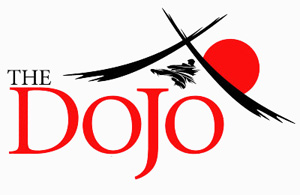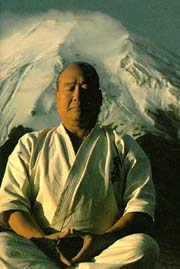What is a Dojo?
(meaning to understand what you are working towards, to follow a certain method that takes you down a specific path to your destination). Therefore the Dojo is the physical & spiritual location where you train. There are some martial artists who would say that the Dojo is an indoor place, such as a gymnasium, hall or a building dedicated to martial arts. However this is traditionally wrong. The word 'Dojo' designates anywhere or any place that one decides to train, your own space, be it inside or outside. Martial art masters such as the great karate master Mas Oyama pictured and the founder of Aikido, master Ushiba at one stage in their lives went into the mountains to train, meditate and be at one with nature. They lived in a small hut and trained out in the open, to them the mountain and the open environment was their Dojo. However the dojo concept has yet to be established.
Teachers taught individually and tailored the techniques to the needs and disposition of the student. Such was the case for men like Itosu Anko (1832-1915), Higashionna Kanryo (1853-1915). The student of these teachers, men like Yabu Kentsu (1866-1937), Hanashiro Chomo (1869-1945), Miyagi Chojun (1888-1953) and Kyoda Juhatsu (1888-1968), were all known to instruct students out of their homes as well. The modern karate dojo did not exist on Okinawa to any real extent during this period in karate's history. So where did the concept of the dojo come from? Not surprisingly, given the influence of the Japanese on Okinawa over several centuries, the karate dojo that we know today is fashioned after the Japanese model, and it too is a relatively recent innovation! As Japan entered the Tokugawa era, relative peace came over Japan. During this period, bushi were no longer being retained by feudal lords for their professional services as warriors. As a result, the bushi were forced to "make their rice" somewhere else. Many of them moved to larger urban centers and opened "dojos" to teach the warrior skills. Unfortunately, many of these new "machi-dojo" (urban schools) were looked down upon for overly formalized or unrealistic training methods. Ju-jutsu dojos are a clear example of how far things had degenerated by the 19th century. Of course, not all schools were interested in selling their skills to prospective students and there were several excellent dojo's that focused on teaching realistic fighting techniques and skills of the professional warrior (For a detailed discussion of this topic see the book by Draeger, 1973; 1973; 1973). It was also during this period of the "machi-dojo" that the concept of fees originated. Traditionally, mainland Japanese bushi were paid a stipend for their services. However, this did not take the form of hard cash as this would have been considered rather vulgar. Only merchants (one class up from the lowest, the "burakumin" or untouchables) dealt with money. Therefore, it was considered good breeding for a bushi not to know much about money, even to the point of not talking about it. Instead, bushi were paid in rice (the fact they turned around and sold the rice for money was conveniently over-looked). However during the Tokugawa period all this changed. Although students today are taught generally indoors such as in a gym or hall, however where-ever one trains is their dojo a place to follow the true way and develope.
Why do karate students say OOS? What does the sound OOS, (sometimes spelt usu) represent within the karate World. Often we hear it said when karate people enters or leaves the Dojo, also it is spoken every time when students bow to one another and every time they greet their karate teacher. The word OOS is an all encumberson word in Japanese terms that means this, I will endeavor to do my very best at the same time showing respect and honour. Although it is Japanese it goes across all boundaries of the martial arts.
|

 Literally:
the place of enlightenment
Literally:
the place of enlightenment